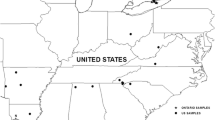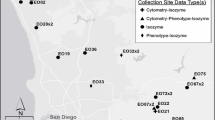Abstract
Intraspecific patterns of genetic variation can often be used toidentify biogeographic divisions which can be especially useful in thedesign of conservation strategies. Although abundant empirical evidenceexist on the genetic characteristics of plant species from the NorthernHemisphere as well as tropical endangered taxa, this information isparticularly limited on threatened species from endemism-rich areas inthe southern Andes of Argentina and Chile. The objective of the currentstudy was to analyze the levels and distribution of the isozymevariation in Fitzroya cupressoides (Mol.) Johnst.(Cupressaceae), a rare conifer restricted to temperate rainforests ofnorthern Patagonia, and to evaluate the role of current conservationareas protecting the gene pool of this valuable long-lived conifer.Sampling schedules consisted of fresh foliage collected from 30 randomlyselected trees at each of 24 different populations located along thegeographic range of the species. Extraction of enzymes followed standardprocedures and homogenates were loaded in 12% starch gels whichwere analyzed by horizontal electrophoresis. Eleven enzyme systems wereresolved using a combination of four different buffer solutions whichyielded information on 21 putative loci, 52% of them werepolymorphic in at least one population. Relatively low levels ofwithin-population genetic variability were scored in Fitzroyapopulations which were approximately half of the typical levelspublished for gymnosperms (percent of polymorphic loci, P = 23 vs.53% and expected heterozygosity, HE = 0.077 vs. 0.155for Fitzroya and other conifers respectively). Substantialbetween-population variation was detected, and certain individualpopulations stand out as much more genetically variable than nearbypopulations, which in turn are located outside protected areas. Ourfindings suggest that if the objective is to protect key species likeFitzroya, spatially explicit genetic information can be auseful tool to attain this goal.
Similar content being viewed by others
References
Allnutt TR, Newton AC, Lara A, Premoli AC, Armesto JJ, Vergara R, Gardner M (1999) Genetic variation in Fitzroya cupressoides (alerce) a threatened South America conifer. Mol. Ecol., 8, 975–987.
Armesto JJ, Rozzi R, Smith-Ramírez C, Arroyo MT (1999) Conservation targets in South American temperate forests. Science, 282, 127–128.
Convention on International Trade in Endangered Species of Wild Fauna and Flora (1984) Publication 50 CFR 23.23. Department of the Interior, U.S. Fish and Wildlife Service.
Cool LG, Power AB, Zavarin E (1991) Variability of foliage terpenes of Fitzroya cupressoides. Biochem. Sys. Ecol., 19, 421–432.
Corporación Nacional Forestal (1974) Legislación Forestal. Corporación Nacional Forestal, Santiago, Chile.
De Azkue D (1982) Los cromosomas de Pilgerodendron uviferum (Don) Flor. Darwiniana, 24, 19–22.
Donoso C, Sandoval V, Grez R, Rodríguez J (1993) Dynamics of Fitzroya cupressoides forests in southern Chile. J. Veg. Sci., 4, 303–312.
Falk DA, Holsinger KE (1991) Genetics and Conservation of Rare Plants. Oxford University Press, Oxford, UK.
Farjon A, Page CN, Schellevis N (1993) A preliminary world list of threatened conifer species. Biodiv. Cons., 2, 304–326.
Ferreyra LI, Latino A, Calderón A, Cardenal CN (1996) Allozyme polymorphism in Austrocedrus chilensis (D. Don) Florin et Boutelje from Patagonia, Argentina. Silvae Genet., 45, 61–64.
Frankel OH, Soulé ME (1981) Conservation and Evolution. Cambridge University Press, Cambridge, UK.
Fraver S, Gonzalez ME, Silla F, Lara A (1999) Composition and structure of remnant Fitzroya cupressoides forests of southern Chile's Central Depression. J. Torr. Bot. Soc., 126, 49–57.
Fundación Vida Silvestre (1999) Mapeo de la Eco-Región de los Bosques Valdivianos. Boletín Técnico, 51. Buenos Aires.
Hair, JB (1968) The chromosomes of the Cupressaceae. 1. Tetraclineae and Actinostrobeae (Callitroideae). N. Z. J. Bot., 6, 277–284.
Hamrick JL, Godt MJW(1989) Allozyme diversity in plant species. In: Plant Population Genetics, Breeding, and Genetic Resources (eds. Brown AHD, Clegg MT, Kahler AL, Weir BS), pp. 43–63. Sinauer Associates, Sunderland, MA.
Hamrick JL, Godt MJW (1996) Conservation genetics of endemic plant species. In: Conservation Genetics, Case Histories from Nature (eds. Avise JC, Hamrick JL), pp. 281–304. Chapman & Hall, New York.
Hamrick JL, Godt MJW, Sherman-Broyles SL (1992) Factors influencing levels of genetic diversity in woody plant species. New Forest, 6, 95–124.
Hogbin PM, Peakall R (1999) Evaluation of the contribution of genetic research to the management of the endangered plant Zieria prostrata. Cons. Biol., 13, 514–522.
Hunziker JH (1961) Estudios cromosómicos en Cupresus y Libocedrus (Cupressaceae). Rev. Invest. Agríc., 15, 169–185.
IFS, International Foundation for Science (1998) Recent Advances in biotechnology for tree conservation and Management, Proceedings of an International Workshop. Universidade Federal de Santa Catarina. Florianópolis, Santa Catarina, Brasil.
IUCN (1994) Red List Categories, IUCN Species Survival Commission. IUCN, Gland, Switzerland.
Kalela EK (1941) Ñber die Holzarten und die durch die klimatischen Verhältnisse verursachten Holzartenwechsel in den Wäldern Ostpatagoniens. Annales Academiae Scientarium Fennicae, Series A, 2, 5–151.
King JN, Dancik BP (1983) Inheritance and linkage of isozymes in white spruce (Picea glauca). Can. J. Genet.Cytol., 5, 430–436.
Kitzberger T, Pérez A, Iglesias G, Premoli AC, Veblen TT. Distribución y estado de conservación del alerce [Fitzroya cupressoides (Mol. Johnst)] en Argentina. Bosque, in press.
Lande R (1988) Genetics and demography in biological conservation. Science, 241, 1455–1460.
Lara A (1991) The Dynamics and Disturbance Regimes of Fitzroya Cupressoides Forests in the South-central Andes of Chile. PhD thesis, University of Colorado, Boulder, USA.
Lara A, Veblen TT (1993) Forest plantations in Chile: A successful model? In: Afforestation Policies, Planing, and Progress (ed. Mather A), pp. 118–139. Belhaven Press, London.
Lara A, Villalba R (1993) A 3620–year temperatyre record from Fitzroya cupressoides tree rings in southern South America. Science, 260, 1104–1106.
Lara A, Donoso PJ, Cortés M (1991) Development of Conservation and Management Alternatives for Native Forest in South-central Chile. Final Report Project 3181 WWF-US/CODEF, Santiago, Chile.
Lara A, Donoso C, Aravena JC (1996) La conservación del bosque nativo en Chile: problemas y desafíos. In: Ecología de los bosques nativos de Chile (eds. Armesto JJ, Villagrán C, Arroyo MK), pp. 335–362. Editorial Universitaria, Santiago, Chile.
Lara A, Fraver S, Aravena JC, Wolodarsky-Franke A (1999) Fire and the dynamics of Fitzroya cupressoides (alerce) forests of Chile's Cordillera Pelada. Ecoscience, 6, 100–109.
Mace GM, Smith TB, Bruford MW, Wayne RK (1996) An overview of the issues. In: Molecular Genetic Approaches in Conservation (eds. Smith TB, Wayne RK), pp. 3–24. Oxford University Press, New York.
Ministerio de Agricultura (1976) Decreto Supremo 490 que declara Monumento Natural al Alerce. Santiago, Chile.
Mitton JB, Linhart YB, Sturgeon KB, Hamrick JL (1979) Allozyme polymorphisms detected in mature needle tissue of ponderosa pine. J. Heredity, 70, 86–89.
Murphy RW, Sites Jr. JW, Buth DG, Haufler CH (1996) Proteins: Isozyme electrophoresis. In: Molecular Systematics (eds. Hillis DM, Moritz C, Mable BK), pp. 51–120. Sinauer Associates, Sunderland, MA.
Nei M (1973) Analysis of gene diversity in subdivided populations. Proc. Natl. Acad. USA, 70, 3321–3323.
O'Malley DM, Allendorf FW, Blake GM (1979) Inheritance of isozyme variation and heterozygosity in Pinus ponderosa. Biochem. Genet., 17, 233–250.
Pastorino MJ, Gallo LA (1998) Inheritance of isozyme variants in Austrocedrus chilensis (D. Don) Florin et Boutelje. Silvae Genet., 47, 15–20.
Poulik MD (1957) Starch gel electrophoresis in a discontinuous system of buffers. Nature (London), 180, 1477–1479.
Premoli AC (1998) The use of genetic markers to conserve endangered species and to design protected areas of more widespread species. In: Proceedings of an International Workshop: Recent Advances in Biotechnology for Tree Conservation and Management (ed. International Foundation for Science), pp. 157–171. Universidade Federal de Santa Catarina, Santa Catarina, Brasil.
Premoli AC, Kitzberger TT, Veblen TT. Isozyme variation and recent biogeographical history of the long-lived conifer Fitzroya cupressoides. J. Biogeogr., in press.
Ranker TA, Haufler CH, Soltis PS, Soltis DE (1989) Genetic evidence for allopolyploidy in the neotropical fern Hemionitis (Adiantaceae) and the reconstruction of an ancestral genome. Sys. Bot., 14, 439–447.
Ricci M, Eaton L (1997) Do all existing Sophora toromiro descend from one individual? Biodiv. Cons., 6, 1697–1702.
Rieseberg LH, Zona S, Aberbom L, Martin TD (1989) Hybridization in the island endemic, Catalina Mahogany. Cons. Biol., 3, 52–58.
Rojas M (1992) The species problem and conservation: what are we protecting? Cons. Biol., 6, 170–178.
Schemske DW, Husband BC, Ruckelhaus MH, Goowillie C, Parker IM, Sishop JG (1994) Evaluating approaches to the conservation of rare and endangered plants. Ecology, 75, 584–606.
Schmithüsen J (1960) Die Nadelhölzer in den Waldgesellschaften der südlichen Anden. Vegetatio, 9, 313–327.
Soltis DE, Rieseberg LH (1986) Autopolyploidy in Tolmiea menziesii (Saxifragaceae): genetic insights from enzyme electrophoresis. Am. J. Bot., 73, 310–318.
Soltis DE, Soltis PS (1989) Isozymes in Plant Biology. Discorides Press, Portland, Oregon.
SUCRE: Sustainable use, conservation and restoration of native forests in southern Mexico and south-Central Chile (1998) In: INCO-DC International Cooperation with Developing Countries: Practical Information and Programmes, Funded Projects, Agriculture and Natural Resources (ed. European Comission), pp. 182. Belgium. Available at http://helios.bto. ed.ac.uk/ierm/research/sucre/sucre.htm.
Threatened Species Conservation Act (1979) Determination that Fitzroya cupressoides is a threatened species. Federal Register, 44, 64730–64733.
Tortorelli LA (1956) Maderas y Bosques Argentinos. Editorial Acme, Buenos Aires, Argentina.
Veblen TT, Ashton DH (1982) The regeneration status of Fitzroya cupressoides in the Cordillera Pelada, Chile. Biol. Cons., 23, 141–161.
Veblen TT, Delamstro RN, Schlatter J (1976) The conservation of Fitzroya cupressoides and its environment in southern Chile. Environ. Cons., 3, 291–301.
Veblen TT, Burns BR, Kitzberger T, Lara A, Villalba R (1995) The ecology of the conifers of southern South America. In: Ecology of Southern Conifers (eds. Enright NJ, Hill RS), pp. 120–155. Melbourne University Press, Carlton, Victoria, Australia.
Watson L.E, Elisens WJ, Estes JR (1991) Electrophoretic and cytogenetic evidence for allopolyploid origin of Marshallia mohrii (Asteraceae). Am. J. Bot., 78, 408–416.
Author information
Authors and Affiliations
Corresponding author
Rights and permissions
About this article
Cite this article
Premoli, A., Kitzberger, T. & Veblen, T. Conservation genetics of the endangered conifer Fitzroya cupressoides in Chile and Argentina. Conservation Genetics 1, 57–66 (2000). https://doi.org/10.1023/A:1010181603374
Issue Date:
DOI: https://doi.org/10.1023/A:1010181603374




